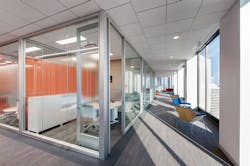Pilot studies are routinely performed in the development of products, technology, research, and services, in order to test the feasibility of an idea on a small scale with minimal financial investment. This same testing process can also be utilized by organizations planning a strategic workplace design to drive business performance. Differentiated from mock-ups or beta sites, workplace pilots are small scale built work environments, where an organization’s employees permanently reside and work on a daily basis. The design of a pilot reflects the workplace strategy solutions being tested, and employees participate in measurement activities during the testing period.
Testing workplace strategy solutions on a small scale before implementing them enterprise wide can provide several benefits to organizations. First, it provides an opportunity for significant long-term costs savings by learning from the challenges and failures identified during the pilot. Building systems and products can be compared, tested and evaluated in a real-world environment. Architectural details are evaluated for road-worthiness before they are repeated tens, hundreds or thousands of times on a larger project. Furniture solutions can be fine-tuned with actual user input. The effectiveness of the workplace design to truly support the business objectives can be measured and tested in real time. These learnings not only apply to the design and architecture of the workplace strategy, but also to the process for transitioning employees in to the new workplace. By testing the overall project management plan that will be implemented when managing the larger project, organizations are able to correct and adjust to ensure the larger project is successful.
Another, softer benefit of a workplace pilot is the impact it can have on the change management effort for the larger project. When employees who reside in the pilot space are taken through a successful and effective change management effort, those employees become ambassadors for the new workplace strategy. As ambassadors, they can describe their own experience working in the pilot and help promote the benefits of the new workplace to their colleagues. In addition, a workplace pilot’s value can last long after the testing has completed and the learnings have been incorporated. It can remain a permanent environment that all employees within the organization can visit, see and touch. This allows employees to experience the benefits of the new workplace for themselves. A personal, positive experience is much more likely to lead to the adoption of desired behaviors, than receiving a communication or presentation about the workplace change.
Workplace pilots can test a variety of workplace design and process solutions, but can provide the most value when they are a true microcosm of a larger strategic real estate project. In those instances, the data and learnings can be far reaching; not only impacting workplace design, but project processes and change management as well.
About the Author
PDR
Based in Houston, PDR specializes in the delivery of innovative workplace design and solutions. As a world-class, workplace consultancy and a premier creative design firm, our integrated services address both business requirements and the work environment to create high performance spaces designed to evolve over time. Check out our blog for more. Follow us on Facebook, LinkedIn, and Twitter.
